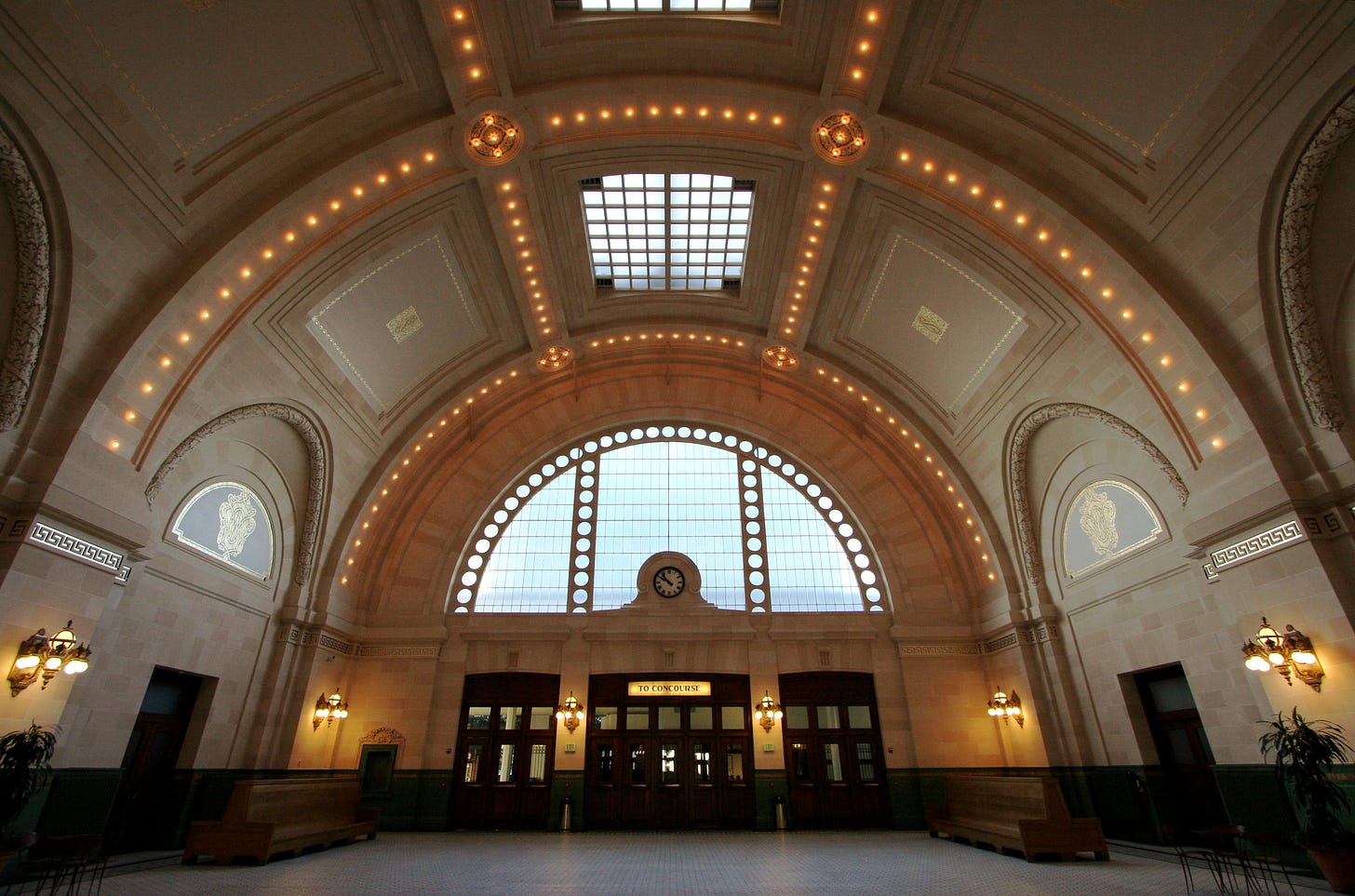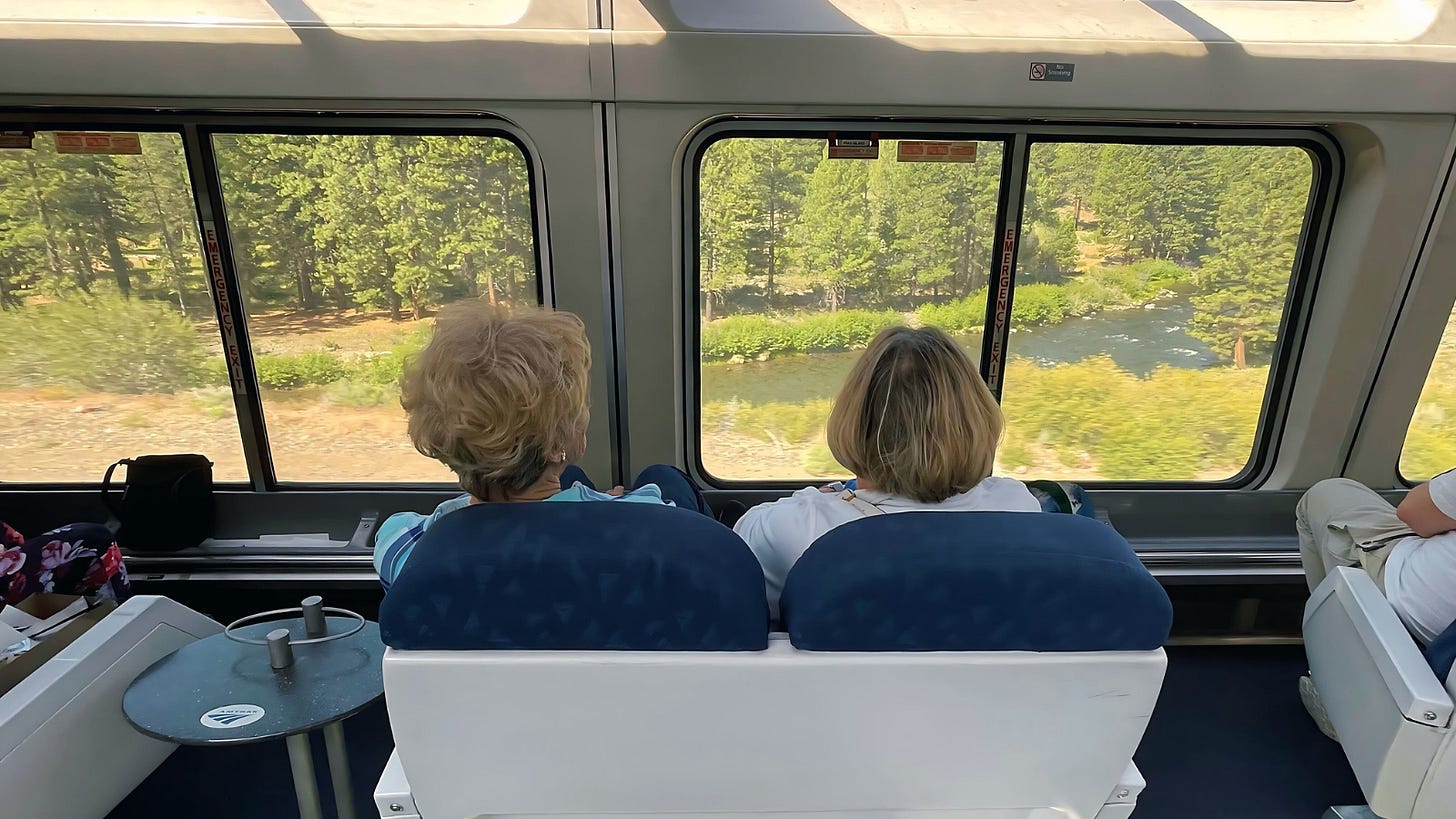Reviving Passenger Rail Isn't Merely Romance
Sure, it's a nostalgic way to travel, but there's more to passenger rail than romance.

We weren’t even officially dating when I asked a coworker at REI if she wanted to join me on a ten-day train ride along the Pacific Coast, from Seattle, Washington to Santa Barbara, California.
To amp up the pressure, the trip wouldn’t be for another month.
A lot can happen in 30 days, presuming she even agreed to go with me. In that same time, we could grow bored of each other, become involved with other people, or learn we weren’t all that compatible.
It was a risky endeavor for two people who barely knew each other.
Travel by train is far more spacious and enchanting than by car or airplane, but you’re breathing room is still limited.
This trip would become either a romantic excursion or an utter train wreck.

Momentum to restore passenger rail to western North Carolina hasn’t been this significant since its discontinuation in 1975.
This enthusiasm is bolstered by Waiting for the Train, a grassroots organization working with local leaders and communities along a proposed passenger rail line between Salisbury and Asheville. Once completed, it would connect Western North Carolina with railroads all over the country.
This revived line is one of seven in North Carolina chosen for further development through the Federal Railroad Administration’s Competitive Discretionary Grants Program. It’s tied to the $66 billion the 2021 Infrastructure Bill has set aside for passenger rail throughout the United States.
Not only is there massive support for passenger rail in western NC, but throughout the entire state.
North Carolina is setting ridership records.
Our state’s intercity passenger rail service, NC by Train, carried over 641,000 passengers in fiscal year 2023, 23% higher than the record set in 2022. It also set a record in March 2024 for monthly ridership, with nearly 67k passengers.
No doubt, community optimism is catalyzed by the fact the federal government is willing to cover 80% of the costs of restoring passenger rail to western North Carolina.
Local governments, state officials, business leaders, and citizens will be vital in contributing to the remaining 20%.
Among the few naysayers that exist, some dismiss passenger rail as little more than a longing for simpler times, fueled by an overly rosy view of trains.
Sure, trains are a nostalgic way to travel, but there's more to passenger rail than romance.
Originally, this ten-day train trip was meant to be a solo venture.
A friend had recently regaled me with stories of his rides on the storied Empire Builder, a train route between Chicago and Seattle. This impressive line graces passengers with unparalleled views of the Mississippi River, Great Plains, Rocky Mountains, Columbia River Gorge, and Cascades.
Arguably, its most picturesque section runs between Montana's Rocky Mountains and the Pacific Northwest Coast—especially once you hit the Cascade Mountains.
Trains maintain a curious profile, alloying a sentimental past with hopes for a more sustainable and egalitarian future.
I hadn’t ridden one since my brief time living abroad in Europe, a continent that boasts far more railway activity per capita than the United States.
My friend’s enthusiasm moved me to ride along the entire Gold Coast alone.

Trains boast a bevy of travel experience advantages over their carbon-emission-heavy peers, beyond providing intrepid travelers an easy way to go far and light on a limited budget.
They are free from the numberless stresses involved in entering and exiting airports with their tedious TSA checkpoints and frustrating baggage claims. Onboarding and off-boarding cramped airplanes are far from pleasant. And planes are cramped spaces.
Passenger trains, on the other hand, are such a lovely way to get places.
Their 360-degree viewing cars are a peak travel experience.
Aside from dining cars, these highly sought-after seats are the other primary gathering places of a passenger train. When traveling more than a day with roughly the same group of strangers, you quickly develop a strange kind of familiarity and routine.
Encounters may be brief, but a sweet camaraderie grows from sharing in the rattle and hum of the tracks, and the periodic stops at train stations—some historic structures lovingly maintained, others newer buildings offering little more than modernist functionality.
Excited children point out the windows at rolling landscapes and silhouetted city lines. They skip along the wide aisles believing the train ride is just as much a part of the adventure as whatever lies in wait at their final destination.
Parents, mostly relaxed, sit next to them, counting their blessings they don’t have to drag ornery children through onerous airport protocols or console their restless bodies after several hours bound to the family minivan.
In standard passenger cars, whether seats are assigned or claimed through habit, you develop a rhythm with your neighbors throughout your multi-day trip.

More than any other mode of travel, passenger rail facilitates moments of community, those fleeting instances of meaningful interactions with others.
You’re not likely to bump into your fellow passengers again once the trip is over, but the length of time strikes a perfect balance of unsuspecting personal conversations and incredibly low stakes.
Plane rides are too crowded to accommodate much conversation without bothering others eager for the wheels to land on the tarmac. And with cars, you’re usually more than well-acquainted with your travel mates.
But with trains, there’s an alchemy that’s difficult to explain.
The exterior scenes roll by at a soothing speed while your world is temporarily constrained to aerodynamic cabins. The gentle rumbling lulls you into a state of safety that makes some people ready to share their loveliest and, sometimes, most heartbreaking inner thoughts.
As William Least Heat-Moon writes in Blue Highways, his travelogue while driving across the many neglected highways throughout the United States, “What you've done becomes the judge of what you're going to do—especially in other people's minds. When you're traveling, you are what you are right there and then. People don't have your past to hold against you. No yesterdays on the road.”
It’s certainly true of trains.
You get people right where they’re at in the moment. They’re going somewhere, likely significant; otherwise, they wouldn’t spend the time and money to travel.
But these treasured moments of community I collected during my time riding the Coastal Starlight weren’t even the most meaningful for me.
Their brevity contrasted with what I hoped would become a far longer-term relationship.
My travel companion agreed to join me for this ten-day adventure. With little hesitation.
“I would love to go with you,” she trilled over the phone when neither of us was certain the other wanted to become more acquainted, let alone travel together a month from now.
Santa Barbara was a wonderful place to visit, its beaches a popular attraction for many, but for us, time together on the train was the destination.
We talked for hours, at times forgetting anybody else was seated nearby or walking the aisles beside us. We slipped in and out of naps and reclined next to each other during the early morning and late afternoon.
We exchanged stories and saccharine gazes.
A naturalist and environmental educator by profession, she frequently drew my attention to the window as we rode through largely untamed nature scapes, pointing out red-tailed hawks and bald eagles in Washington, or marine mammals as the route kissed up against the ocean near San Luis Obispo.
To say little of witnessing the unrivaled grandeur of the redwoods in Northern California, some of the most godlike beings humans encounter.

We drank up the experience; basked in the sun of the viewing car; and let ourselves become moony-eyed as we laughed endlessly through silly travel games, such as “Would You Rather?” and “Ketchup or Mustard.”
On the second day of the train ride, I wrote in my journal: “It's already been 36 straight hours together and we're blissfully happy. I think we'll be fine.”
After a few-day stay with friends in Santa Barbara and the return ride to Seattle, we were completely smitten. With each other, and with travel by train.
Two months later she said, “I love you,” during a hike in the Cascades.
She had written and concealed those three weighty words on the underside of several Oregon grape leaves she cleverly placed in my hand, asking me to identify the plant. This was another game she loved to play on our many hikes through wilderness areas—forests mostly unsullied by clamorous highways and roads.
Several months later we moved in together.
Then we adopted a German shepherd from our local animal shelter. And nearly three years after our trip on the Coastal Starlight, we were engaged.
I have no way of knowing whether we would’ve ended up together had we not taken a chance riding the tracks. “The train ride,” as we endearingly call it, is central to our story as a couple.
Trains brought us together. And nurtured a young love that has since matured into a grounding force in both our lives.
But that’s not the only reason I’m such a train enthusiast.
It’s the gateway that got me to deeply consider the value passenger rail offers us twenty-first-century denizens. It invited me to research the benefits passenger rail brings to communities.
Let me share just a few.
Passenger trains reduce carbon emissions, stimulate local economies by attracting tourists, create jobs, and encourage development around train stations.
Rail services breathe new life into neglected urban and rural communities, making them more vibrant and attractive for residents and visitors.
In Japan, it’s not uncommon for small villages to boast an active train station, granting rural folks the perks of small-town living and the benefits of a well-connected network of routes to carry them to urban centers.
I want that for Appalachia.
Deeply.
Automobiles are far more dangerous than trains, having, perhaps, more in common with missiles than they do their transportation progenitors. How many people die by automotive vehicles each year?
We’ve allowed ourselves to accept an automotive epidemic.
Road fatalities are just the price we pay for “freedom,” we tell ourselves. “That’s just the way it is.”
Passenger trains also reduce road congestion and the construction of highways that mar beautiful countryside and kill or maim wildlife that dare to venture across them.
Rail service links up communities, making it easier for people to access better jobs, education, healthcare, and recreational opportunities. It bridges gaps between rural and urban areas and fosters regional cohesion.
Trains give us a stronger sense of place.
Travel by train also counteracts the forces of isolation and atomization that leave us lonely and disconnected from one another. The so-called “freedom of cars” means we interact less with each other, especially those who have backgrounds different from our own.
Cars lock us into solitary confinement where we view other people in their high-speed metal boxes more as potential threats to our physical safety than as community members we ought to know and care for.
I return to the original question: Is support for passenger rail merely romance?
Yes, passenger rail is romantic and endlessly charming, but it’s so much more. It's a route forward for addressing many of our twenty-first-century problems.
Restoring passenger rail is, I believe, central to ushering in an Appalachia that’s more egalitarian, sustainable, economically prosperous, and community-minded than the one we have today.
And maybe it’ll even conjure up more love stories.



Sounds like a magic train ride. Riding through the Old Fort loops is gonna be stunning
I hear so much about people's experiences riding the line when it used to go up to AVL. Looking forward to this